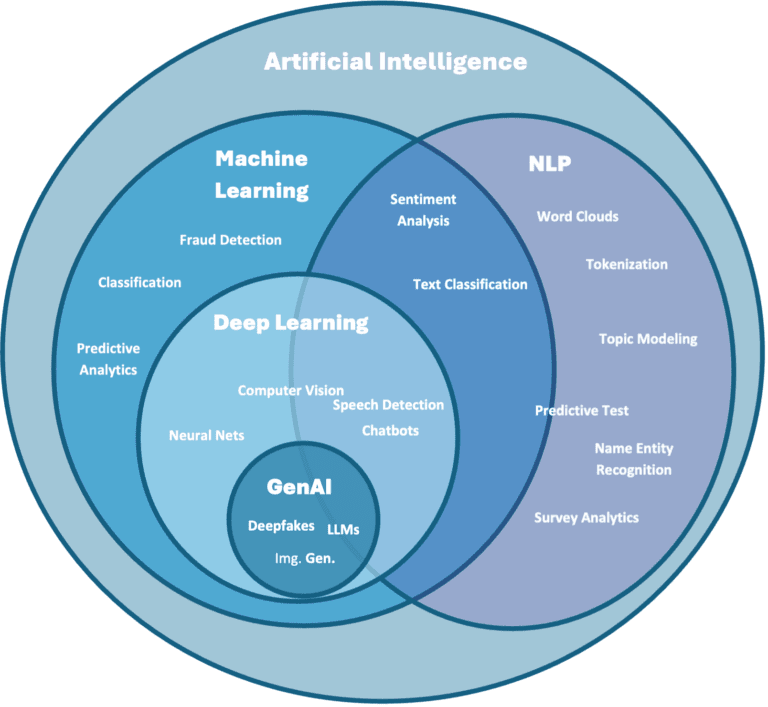According to Gartner, we’re quickly moving beyond the hype phase for investment and projects in AI, where value creation will reign king in the months ahead. The potential value to be realized is in part because AI isn’t just one thing – it encompasses a vast range of tools and capabilities across the value realization and adoption maturity spectrums.
As a business or tech leader, we know this space is evolving rapidly before our eyes – and our aim is to help you to deliver sustainable impact, while being armed with the knowledge you need for critical decision-making and long-term success.
Answer these important questions to plan your AI journey
When considering how to leverage AI in your organization, it’s essential to answer an important set of questions: What do I want AI to do for my company, and what value can be achieved? Once you have a strong business case and measurable outcomes in mind (with financial benefits being critical), you will be in a strong position to assess and select the type of AI that is best able to deliver the desired results.
At the highest level, AI can be categorized as either traditional AI or generative AI. Let’s explore each in more detail:

Traditional AI – leveraging large, proprietary data sets.
This form of AI leverages a company’s proprietary data to provide answers to very specific questions – it’s great for analyzing large, complex and usually well-structured data sets for patterns. It includes technologies such as machine learning, computer vision, audio analysis, and large data set pattern recognition. For example, it is great for predicting trends based on historical data and finding outliers.
Don’t underestimate the importance of traditional AI because of the term “traditional”—these technologies are evolving rapidly, and can have a significant impact on a business. Rather, the traditional classification is reflective of the fact that traditional AI is mature and relatively mainstream, meaning that while cost and effort are a factor in success, it’s often feasible to reliably predict whether value can be derived from the effort (especially if invested in incrementally).
Successful traditional AI implementation is dependent upon a solid data foundation which often requires extensive resources and expertise to prepare the data. Data sourcing, cleaning, collecting, and preparation is usually a significant effort, but, once the foundational effort is in place, the algorithms have the ability to improve without human intervention.
The use cases for traditional AI are vast. Most people have personally experienced traditional AI. For example, to identify what song is playing through Spotify or to optimize their travel route through a mobile app such as Waze. Cuesta has helped clients who use computer vision to recognize and read license plates, analyze X-Ray images for issues, or to optimize their pricing. We summarized how 100 retail and consumer companies are using these technologies—you can read more here
Generative AI – pushing new boundaries through natural language processing.
Gen AI is a somewhat more complicated topic. To start with, all forms of Gen AI use natural language processing and are, at their core computer language processing. In other words, Gen AI takes an input (audio or text) and derives the intent of the words, then creates words, synthesizes audio or creates imagery as an output using a model that’s trained on data. Gen AI can be trained on structured and unstructured data.
We think about Gen AI in two broad categories—one uses the world’s data and the other uses the world’s data AND proprietary company data.
Publicly available generative AI tools are good for answering general questions that are not dependent upon a company’s data and don’t require a great deal of precision. Most people are familiar with Gen AI through tools like ChatGPT, Gemini, Claude, and Copilot. While there has been huge buzz over the evolution of Gen AI over the past two years, in most cases companies are only just beginning to experiment with how to leverage it at scale and beyond individual use cases in the enterprise.
Proprietary generative AI brings a company’s proprietary data and the world’s data together to address questions with a greater degree of precision. This area is the most nascent but has the greatest opportunity to meaningfully redefine what’s possible and generate value at scale for organizations.
Gen AI has some innate strengths and weaknesses. It’s great for use cases in human-based businesses (e.g. customer support, sales, etc.), and it really shines when it comes to analyzing and using unstructured data. However, it’s predictive and not an information retrieval system. These large language models can hallucinate (e.g., make stuff up), and have limitations when it comes to left brain activities such as analytics and financial modeling.
The use cases for Gen AI have only begun to be defined. Most people have encountered Gen AI through chatbots. Cuesta has helped clients with use cases such as reading emails to extract order details and enter them into enterprise systems to enable action, or to produce tailored images of products with varied features or backdrops.
While it’s easy to access generative AI at an introductory level, only some of the most technically advanced companies are investing in this space at scale. There are many barriers to successfully leverage generative AI, including customer trust, an evolving regulatory landscape, infrastructure, data, talent, policies and standard operating procedures, and change management, to name a few. Many of these hurdles are magnified when considering proprietary generative AI.
Unlike traditional AI, Gen AI is a relatively immature technology: it’s currently providing <1% of the actual value, but it has tremendous potential and is evolving very quickly, so it’s worth thoughtful investment and experimentation in this space.
A strong data foundation is essential for your AI journey ahead.
In summary, the usefulness of AI is as potentially broad as the usefulness of language magnified by massive computing power that can harness your company’s proprietary data and the world’s data to help you make decisions, automate tasks, and predict behaviors.
Cuesta Partners often works with companies with less mature data foundations who are anxious to advance their AI capabilities and maturity. In these situations, we advise “data first, AI second,” as AI results are only as good as the data behind them. When a company has a solid data foundation the opportunities to experiment with and scale AI solutions are as limitless as one’s imagination to come up with compelling, value-based use cases.
Reach out to us to learn more, to speak with one of our experts, and to see some of our case studies in action!




